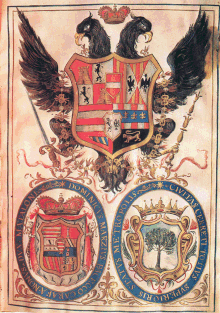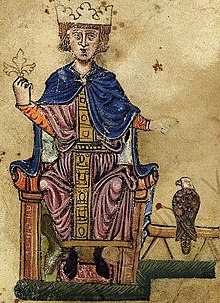Universitas (southern Italy)

Universitates (from the Latin universitas, -tis), also called università del Regno (or simply "università"), is the term that generally designates the communities of southern Italy that were established under the Lombard rule and later after the conquests by the Normans were enfeoffed . Their historical development differs from the free municipalities that emerged in northern Italy in the Middle Ages.
In general, it is about “a certain collective body, the universitas civium or universitas loci , which is self-governing in certain areas and with certain traditional powers depending on a higher authority (royal, feudal, civil) with which it is self-governing in the case of ordinary or extraordinary Occasions of signing treaties (surrender, surrender, surrender of rule or dynasty) and their own constitution (and the reform of the same), both the modalities and sometimes the stock of their own contributions to cash and services ”.
During the reign of Frederick II , the term " community " was used, while Charles I of Anjou converted it into universitas (from universi cives , "association of all citizens") and ordered the destruction of the city seals. They survived until the abolition of feudalism by the decree of August 2, 1806 by Joseph Bonaparte .
history
After the advance of the Lombards, many communities in southern Italy retained their own property and institutions, some of which date back to Roman times. The Normans gave these lands as fiefs to trustworthy people and took away their autonomy, but mostly respected the old habits. Later Frederick II of Swabia restricted the privileges of the landowners and recognized the legal personality of the universities .
Under the governments of the Angevin and Aragonese , the number and power of local feudal lords increased considerably, weakening royal power and severely restricting the choice of university officials . The latter were unable to remedy the situation and gave in to feudal pressures or, on the contrary, tried to declare themselves royal state property, which in turn sparked long, expensive and unnecessary disputes at the Holy Royal Council of Naples . Other municipalities, on the other hand, attempted to reach an agreement with the landowners by issuing municipal laws defining mutual obligations and rights and regulating civil, criminal , commercial and administrative law of the municipality. The same legal and institutional form (the Universitas) therefore had very different settlement and political conditions, from the rural village to the city to their own internal structure. They represented - either permanently or occasionally - social partners or parts of the territory.
The tensions between the feudal lords and the magistrates of the Universitates reached a climax with the rule of Alfon of Aragon when he gave the barons the " Mero e Misto Imperio ", d. H. full jurisdiction in civil and criminal matters, confirmed and granted them the " Quattro lettere arbitrali ", which had previously been ordered by Robert of Anjou and given only to the official royal representatives. This gave them the privilege of converting sentences into higher sentences than those stipulated by law, of judging certain crimes ex officio and of torturing the perpetrator without time limit. On the other hand, the landowners paid the king the relevio (half of their first year income), adoa (military financial aid), and investiture service.
In 1316, 1259 universities were registered, the number of which increased in the following centuries.
The Universitates survived the various movements of the 18th century and regained full power in 1806 after the abolition of feudalism in the Kingdom of Naples .
The term Universitas , widely used in the law of the Kingdom of Naples , was no longer used after the unification of Italy in favor of the term municipality , although it is not exactly a synonym. Indeed, from a legal, but also from a historiographical point of view, the Universitas is the category and the congregation is the species, because the congregations were “autonomous” but not “independent”.
order

The organization of the various universities was based on an assembly made up of the noblest or most worthy heads of families, who each year elected a council composed of a number of members who varied according to the population (90 council members in Aversa , 36th in Molfetta , 6 in Caiazzo , 12 in Cerreto Sannita . Nocera was a unique city with an allied Università structure). The Syndici (syndicus = mayor) were appointed or elected from among the members of the council , including an erario licteratus (a representative who had to be able to read and write). There were also numerous other positions and the various city offices: for the determination of weights and measures, for the administration of justice, for the safety of citizens, for the maintenance of streets, walls and doors.
The administration of a Università was entrusted to officials chosen from among the population, with the exception of clergy and nobles. You were in office for a year and were responsible for either the financial or the judicial part. However, an external control was provided: the administration of justice was supervised by the provincial judges, the financial responsibility was the responsibility of the Capitani del Re , who were also responsible for maintaining public order. Since there was not a single person in charge, the administrative structure was headless.
From there the Casali were founded, villages in the open country for the farmers to avoid the long commutes to work. Later on, these Casali gained their own autonomy over many administrative matters.
Depending on the property, there were the Universitates feudali , if they are subject to a feudal lord, or demaniali, if they are the property of the crown.
Universitates feudali
The Universitates feudali were owned by a feudal lord who administered them (often from vassals). They then went from castle to castle, selling and buying them like any other commodity. And it was not just the land that changed hands, because the same fate suffered the people and animals associated with them.
The administration of justice was entrusted to the nominated feudal judges, who however took the oath on the provincial judge.
In other areas, the powers of control of the capitano del re were generally very limited, also because the feudal lord often made him castellan (i.e. administrator of the fief ), which made the resulting conflict of interest to his advantage.
Università demaniali
The Universitates demaniali (10% of the total) were dependent on the crown and administered by royal officials. They enjoyed greater freedom and privileges as they could turn to higher officials in the event of abuse by the administrators and usually received redress.
The administration of justice was carried out by the provincial judicial officer, the curia dei bàiuli (or curia dei baglivi ). She was responsible for the urban and rural police service, collecting fines, arresting criminals and fugitive servants, checking weights and measures, etc.
The Baiuoli were divided into two roles: the iudices ad contractus et ad causas administered the judiciary, while the iudices ad conactus tantum as representatives of the royal authority only dealt with the conclusion of public and private contracts.
They were honorary judges , stayed in office for a year, and were chosen from the most famous people, but clerics and nobles were excluded.
The staff of the Università also included the public auctioneer and the mastrogiurato. The latter particularly supported the captain in the police force: he sent summons to appear in court, received reports which he then passed on to the executioners, prevented the spread of forbidden weapons, punished gamblers, usurers and even blasphemers. The proceeds from the fines imposed by the Mastrogiurato did not go to the tax authority, but were donated to the executioners. This created a conflict of interest that often resulted in illegal behavior.
The universitates achieved as institutions the status of the Free Cities of the Holy Roman Empire and the Bonne ville of France .
literature
- Alianello: Delle consuetudini e degli statuti municipali delle province napoletane . Naples 1873 (Italian).
- Benedetto Croce: Storia del Regno di Napoli . Laterza, Bari 1966 (Italian).
- Vincenzo Mazzacane: Memorie storiche di Cerreto Sannita . Liguori Editore, Cerreto Sannita 1990 (Italian).
- Savioli: Manuals di storia del diritto italiano . Turin 1889 (Italian).
Individual evidence
- ^ A b Francesco Senatore: Gli archivi delle Universitates meridionali: il caso di Capua ed alcune considerazioni generali . 2009, ISBN 978-88-7125-297-1 (Italian, unina.it [PDF]).
- ↑ a b Mazzacane, Memorie storiche ....
- ^ Croce B., Storia del Regno di Napoli
- ↑ Nicola Vigliotti: sorgere e sviluppo delle Universitas nell'Italia meridional . In: Note su Limata . Edizioni Realtà Sannita, 2001 (Italian).